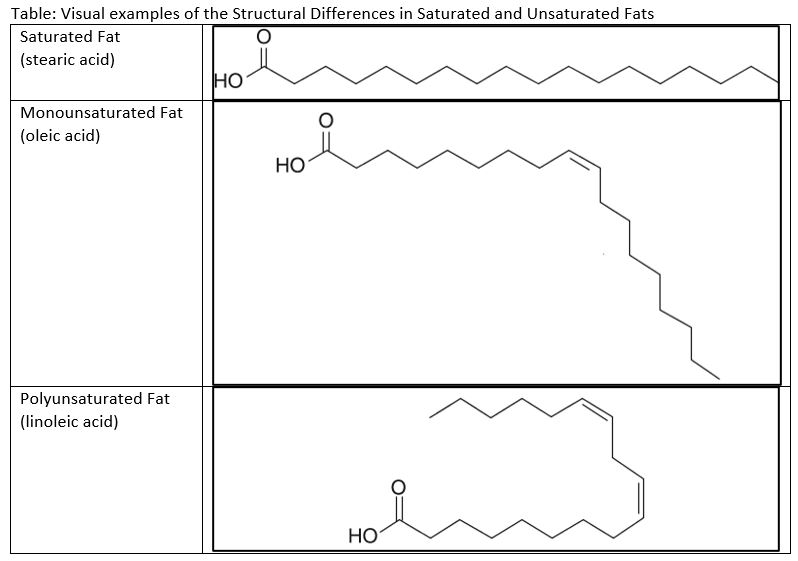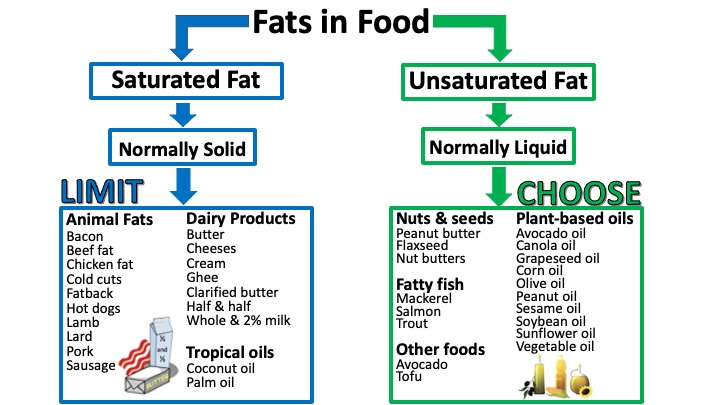Fats are essential for life and are the most energy-dense macronutrient, containing nine kilocalories per gram.1 The two main types of dietary fats are saturated and unsaturated fats, differentiated by their chemical composition and structure. Most fats found in food are molecules composed of a glycerol backbone with fatty acids attached. Fatty acids are chains of carbon, hydrogen, and oxygen.1 The fatty acids in fats differ in the length of the carbon chain and degree of saturation with hydrogen atoms, impacting the physical properties and health effects.
Even though fats are categorized as saturated or unsaturated, foods usually contain both saturated and unsaturated fats. The fat type of greatest abundance in a food usually determines the classification of that food as a saturated or an unsaturated fat.1 For example, olive oil has a high content of oleic acid, an unsaturated fatty acid, and a smaller quantity of saturated fat; therefore, olive oil is classified as an unsaturated fat. The health effects of consuming foods and dietary patterns of differing amounts of saturated and unsaturated remains an area of active investigation. 1-14
We conducted a review of the literature, clinical practice guidelines, and national association recommendations and publications to identify relevant information on saturated and unsaturated fats. The detailed methods and results of this review are available upon request. The aim was to describe the difference between saturated and unsaturated fats.
Saturated Fats
A saturated fat molecule contains only fatty acid chains with no double bonds between the carbon molecules. The fatty acid chains are ‘saturated’ with hydrogen molecules.1 A visual representation of the structure of the saturated long-chain fatty acid, stearic acid, is provided below. Saturated fats are typically solid at room temperature because complete saturation causes the molecules to pack closely together.1-6 Dietary sources high in saturated fats include meats, whole and 2% dairy products, and animal fats like butter, lard, and tallow.2 Solid vegetable fats, as well as some plant-based fats such as coconut oil, palm oil, palm kernel oil and cocoa butter, are also high in saturated fat content.2
The USDA Dietary Guidelines for Americans, 2020-2025 recommends that saturated fat consumption be limited to less than 10% of daily calories for all healthy persons two years of age and older, while the American Heart Association recommends no more than 5-6% of daily calories come from saturated fats for primary prevention of cardiovascular disease.2-8 For a person consuming 2000 calories per day, this is equivalent to limiting saturated fat intake to 11-22 grams or less per day. For reference, one tablespoon of butter contains 7 grams of saturated fat.
Unsaturated Fats
Molecules of unsaturated fats have fatty acids with at least one unsaturated carbon bond, called a double bond.1 The double bond forms a “kink” or bend in the molecule, which causes the molecules to pack less tightly together. This provides an explanation for unsaturated fats being liquid at room temperature.
There are two types of unsaturated fatty acids – monounsaturated and polyunsaturated. Monounsaturated fatty acids have one unsaturated carbon bond or one double bond.12 Polyunsaturated fatty acids have more than one double bond.13 A visual representation of the structures of monounsaturated and polyunsaturated fatty acids is provided below. Omega-3 fatty acids (linolenic acid) and omega-6 fatty acids (alpha-linoleic acid) are both polyunsaturated. Dietary sources high in unsaturated fats include non-tropical plant-based oils, nuts, seeds, fish, and certain vegetables such as avocados.12-13
The USDA Dietary Guidelines for Americans, 2020-2025 and the American College of Cardiology and American Heart Association recommend replacing saturated fats in the diet with unsaturated fats, especially polyunsaturated fats. 7,8,14 The Dietary Guidelines for Americans recommends all persons aged two and older, including pregnant women, consume unsaturated fats from unsaturated vegetable oils, seafood and nuts as part of a healthful dietary pattern.
Summary of Evidence
The difference between a saturated fat and an unsaturated fat is the degree of saturation, or the number of double bonds, in the fatty acid chains. Because of their different chemical structures, saturated fats are often solid, and unsaturated fats are liquid at room temperature. The health effects of consuming dietary saturated and unsaturated fats differ. Guidelines consistently recommend consuming healthy dietary patterns low in saturated fat and substituting foods with unsaturated fats for foods high in saturated fats.

References
- Stipanuk MH, Caudill MA. Biochemical, physiological, and molecular aspects of human nutrition. Fourth edition. ed. xiv, 959 pages.
- American Heart Association. Saturated fat. 2018. https://www.heart.org/en/healthy-living/healthy-eating/eat-smart/fats/saturated-fats.
- Hooper L, Martin N, Jimoh OF, Kirk C, Foster E, Abdelhamid AS. Reduction in saturated fat intake for cardiovascular disease. Cochrane Database Syst Rev. Aug 21 2020;8:CD011737. doi:10.1002/14651858.CD011737.pub3
- Sacks FM, Lichtenstein AH, Wu JHY, et al. Dietary Fats and Cardiovascular Disease: A Presidential Advisory from the American Heart Association. Circulation. Jul 18 2017;136(3):e1-e23. doi:10.1161/CIR.0000000000000510
- Wolters M, Ahrens J, Romani-Perez M, et al. Dietary fat, the gut microbiota, and metabolic health - A systematic review conducted within the MyNewGut project. Clin Nutr. Dec 2019;38(6):2504-2520. doi:10.1016/j.clnu.2018.12.024
- Calabrese I, Riccardi G. Effectiveness of Changes in Diet Composition on Reducing the Incidence of Cardiovascular Disease. Curr Cardiol Rep. Jul 27 2019;21(9):88. doi:10.1007/s11886-019-1176-y
- Dietary Guidelines for Americans, 2020-2025. S. Department of Health and Human Services and U.S. Department of Agriculture. 2020.
- Dietary guidelines advisory committee and nutrition evidence systematic review team. Scientific Report of the 2020 Dietary Guidelines Advisory Committee: Advisory Report to the Secretary of Agriculture and the Secretary of Health and Human Services. Washington, DC: U.S. Department of Agriculture;2020.
- Kris-Etherton PM, Krauss RM. Public health guidelines should recommend reducing saturated fat consumption as much as possible: YES. Am J Clin Nutr. Jul 1 2020;112(1):13-18. doi:10.1093/ajcn/nqaa110
- Krauss RM, Kris-Etherton PM. Public health guidelines should recommend reducing saturated fat consumption as much as possible: NO. Am J Clin Nutr. Jul 1 2020;112(1):19-24. doi:10.1093/ajcn/nqaa111
- Krauss RM, Kris-Etherton PM. Public health guidelines should recommend reducing saturated fat consumption as much as possible: Debate Consensus. Am J Clin Nutr. Jul 1 2020;112(1):25-26. doi:10.1093/ajcn/nqaa134
- American Heart Association. Monounsaturated fats. 2018. https://www.heart.org/en/healthy-living/healthy-eating/eat-smart/fats/monounsaturated-fats
- American Heart Association. Polyunsaturated fats. 2018. https://www.heart.org/en/healthy-living/healthy-eating/eat-smart/fats/polyunsaturated-fats
- Arnett DK, Blumenthal RS, Albert MA, et al. 2019 ACC/AHA Guideline on the Primary Prevention of Cardiovascular Disease: A Report of the American College of Cardiology/American Heart Association Task Force on Clinical Practice Guidelines [published correction appears in Circulation. 2019 Sep 10;140(11):e649-e650] [published correction appears in Circulation. 2020 Jan 28;141(4):e60] [published correction appears in Circulation. 2020 Apr 21;141(16):e774]. Circulation. 2019;140(11):e596-e646. doi:10.1161/CIR.0000000000000678



